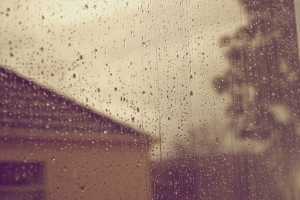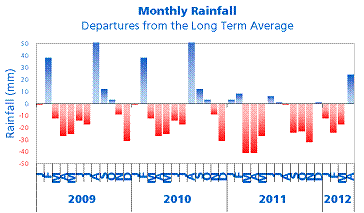Will one really wet month make the drought go away?
Posted on May 4, 2012
 The recent downpours of heavy rain have provided some welcome relief for farmers, gardeners and the environment in our drought-hit region. In fact, this April has been the wettest for almost 100 years. Unfortunately, though, our groundwater resources, which make up almost half of all the drinking water we supply, take longer to replenish.
The recent downpours of heavy rain have provided some welcome relief for farmers, gardeners and the environment in our drought-hit region. In fact, this April has been the wettest for almost 100 years. Unfortunately, though, our groundwater resources, which make up almost half of all the drinking water we supply, take longer to replenish.
Seeing rain stream down the window and the swollen rivers, it's hard to believe there can still be a shortage of water. But after such a long period of dry weather we are going to need more than a few wet weeks to cancel out the deficit caused by many months of below average rainfall.
Mike Cook, Head of Water Resources explains why;
"We operate in the driest part of the country and have to carefully manage water resources to ensure we have enough for our 4.2 million customers.
"Up until the end of March, we had experienced the driest 18 months for 100 years, only receiving between 60 and 80 per cent of the rainfall we normally expect."
"This exceptionally dry period spanned two winter periods during which reservoirs and rivers would normally refill and recover."
What happens when it rains, where does the water go?
After a lot of rain the rivers look a lot higher, but this change only lasts as long as the rain does. Anglian Water captures a lot of the rain that flows into the rivers, and pumps it into reservoirs. Most of these are recovering well following the recent rainfall – but reservoirs only supply half of the drinking water we need in our region.
The graph below shows just how much below average rainfall we have had in the past few years compared to what we would normally expect.
Data source: Met Office

Around half of the drinking water we supply comes from ground water sources, such as wells and boreholes. These are holes drilled into the ground into layers of permeable rock which hold water. These layers of rock (aquifers) recharge very slowly and so are less affected by small fluctuations in rainfall.
After a long dry period, it can take some time for the ground to soak through before rain can filter down to the rock. Aquifers are normally replenished between October and April, but sadly because the last two winters have been so dry, replenishment has been very low.
Of the water that soaks into the ground some is used by plants and some evaporates, instead of soaking into our aquifers where we need it.
The recent heavy rainfall has led to some recharge in shallow aquifers but the response in deeper aquifers will be slower and will take another year to recover fully. In some areas, the rainfall needs to travel down more than 50 metres before it reaches the water table.
To find out more about drought and ground water resources see Who, What, Why: How much rain is needed to ease the drought?
Source: Drought Matters Update, Anglian Water
Comment on This Article:
All HTML, except <i>, <b>, <u> will require your comment to be moderated before it is publicly displayed.
If you would like your own avatar displayed, read about comment avatars.
Reader Comments
Be the first to comment on this article using the form below.